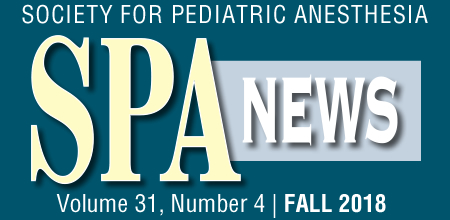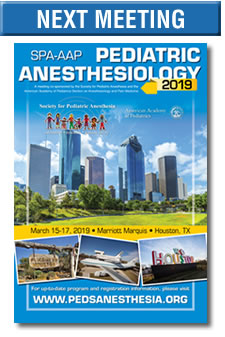meeting reviews
Session IV: PEDx Talks. Less But Better. Part 2
Reviewed by Faith J. Ross, MD, MS
Seattle Children’s Hospital, Seattle, WA
PRAN Update
Benjamin Walker, MD (American Family Children’s Hospital, Madison) continued the afternoon PedEx Talks with an update from the Pediatric Regional Anesthesia Network database, citing his group’s recent publication in Anesthesiology. The PRAN database has grown almost exponentially over the past decade and now includes almost 150,000 blocks. The most recent data reconfirms the safety of regional anesthesia with an extremely low incidence of serious complications (on the order of one in 10,000). There were no identified long-term neurologic motor deficits, and only two sensory deficits. Local anesthetic toxicity rates are lower in children than adults, although children under six months of age appear to be at significantly higher risk. As before, regional anesthesia under general anesthesia was found to be as safe as, if not safer than, awake regional anesthesia. (The age-adjusted risk for awake blocks was OR 2.93.)
There were some commonly-held ideas that were not borne out by the data. The study did not demonstrate that increased use of ultrasound guidance has decreased the incidence of complications or toxicity, or that peripheral blocks are safer than neuraxial blocks. There was also no clear evidence that thoracic epidurals were more associated with complications than epidurals placed in the lumbar or caudal space; however, case reports of catastrophic complications have been largely from thoracic epidurals. Contrary to popular teaching, there was not evidence of a higher risk of infection in caudal catheters than in other epidural catheters. Instead, the duration of catheter use was the strongest risk factor for infection.
In determining the role for regional anesthesia in perioperative management, it is important to bear in mind the other intraoperative risks, including the risk inherent to the surgery and to general anesthesia, and the potential benefits of regional anesthesia. Studies on the long-term benefits from regional anesthesia are so far lacking. Unfortunately, PRAN does not allow us to address the question of benefits of regional anesthesia. Further prospective studies on this topic will be essential in determining the role of regional anesthesia in the future as surgical approaches and multimodal analgesic options evolve.
Progressive Mobility in the PICU
Sapna Kudchadkar, MD (Johns Hopkins, Baltimore) discussed progressive mobility in the pediatric intensive care unit (PICU). Play is an essential component of childhood development and has an important role in normal development as well as in coping with challenging situations such as surgery and hospitalization. In the ICU, immobility is the norm, and has historically been considered essential to physiologic recovery. However, children often leave the ICU with diminished function that persists long after hospitalization. More recently, the paradigm has shifted, and physicians have come to recognize the potential benefits of mobility in recovering from serious illness.
Heterogeneity in ages and development complicate attempts to uniformly apply mobility plans to all patients. Concerns about accidental removal of lines and tubes and fear of psychological trauma lead to oversedation, delirium, and use of restraints. Furthermore, common hospital routines of overnight bathing, daily x-rays and labs, and early morning rounding disrupt natural sleep schedules, necessitating increased sedation and further disruption of natural sleep cycles.
Dr. Kudchadkar’s group has challenged the traditional dogma of immobility and sedation in the ICU by instituting a protocol for progressive mobilization in critically ill patients. The PICU Up! program at Johns Hopkins uses a validated QI tool to create an activity progression to encourage some level of activity in all PICU patients. They also focus on re-creating physiologic sleep/wake cycles. There were no adverse events over the course of their study and they were successful in increasing mobilization.
Dr. Kudchadkar shared the story of one nine year-old PICU patient who was able to walk the hallway and play in the playroom while intubated. She also shared the story of a two year-old who was up riding in a toy car only 16 hours after her Fontan surgery. Even young infants have been able to be awake and tolerate endotracheal intubation under this program. Other units around the world from Brazil to England have implemented these mobility tools with similar success. Based on these impressive results, it appears that early mobility may play an important role in recovery for many critically ill patients in the future.
ACS Children’s Surgery Verification Program
Lynn Martin, MD, MBA, FAAP (Seattle Children’s Hospital, Seattle) discussed recent drives to improve pediatric surgical outcomes. We have clearly come a long way in patient safety over the past few decades; however, population level studies show opportunities for improvement in various surgical subspecialties. For example, studies have shown improved cardiac surgical outcomes in higher volume centers. Similarly, children treated in pediatric-specific trauma centers have better outcomes than children that receive treatment in adult trauma centers. Even children undergoing common surgical procedures (appendectomies and pyloromyotomies) fare better, experience fewer complications, and have shorter lengths of stay at pediatric hospitals than in community centers. Furthermore, anesthesiologists who treat children more frequently have lower rates of complications in children.
The American College of Surgeons (ACS) Children’s Surgery Verification Program seeks to improve outcomes and lower costs in the pediatric surgical population. This program task force began in 2012 and worked for three years to develop center standards and scopes of practice to better match resources to patient needs. They established a tiered center designation (level 1, 2, 3) similar to trauma center designation. The verification program approved by the ACS was formally launched in 2017 and there are now 11 centers that have been formally reviewed and certified as level 1 pediatric surgical centers.
Some anesthesiologists have cautioned that such designation could raise problems in the matching of patients to resources that would be required with such an approach; for example, delays in surgical timing, and the cost to transfer patients to higher-level institutions. Drawing an analogy to trauma designation, Dr. Martin discussed improvements in mortality and decreased incidence of inappropriate care and preventable death in patients cared for in designated trauma centers. To address the question of costs and delays associated with transfer in the setting of trauma, studies have shown no impact of transfer on mortality or complication rates. Movement of high-intensity patients to designated centers allows the lower-acuity institutions to better provide care to other patients and reduces their rate of transfer of other patients. Hopefully as this program grows and matures there will be better matching of resources to patient needs and improved quality of care for all children.
DCD and Organ Donation
Mark Twite, MD, BCh (University of Colorado, Aurora) discussed the complicated issue of organ donation after cardiac death in children. Supply/demand mismatch in pediatric organ donation causes many patients to wait long periods for an appropriate organ with 120,000 patients on the waitlist for 35,000 organs each year.
There are classically two pathways for cadaveric organ donation. Most commonly, organs are donated after brain death (DABD). However, organs can also be retrieved after cessation of circulatory function (DCD). The quality of harvested organ differs based on the method of death. DABD allows well-planned removal of organs from recipients that can be meticulously managed in anticipation of surgery. Thus, organs procured via DABD are in general more likely to be successful grafts.
In DCD, the patients have suffered a devastating neurologic injury but do not meet the strict criteria for brain death. Mechanical ventilation is withdrawn in the OR and death is declared. Typically physicians wait two to five minutes after death before harvesting of organs. This arbitrary time designation has historical roots without a sound physiologic basis and may risk the success of transplantation by contributing to increased duration of organ ischemia. There are so far very few cases of pediatric heart transplantation after DCD.
Future efforts focus on minimizing ischemic time to donor organs. For example, timely institution of EMCO after cardiac death may improve organ perfusion and viability. In the US, some organs are resuscitated using individual organ perfusion systems prior to implantation.
DCD may, in the future, increase the availability of donor organs and allow families to honor the wishes of their loved ones to donate even in the absence of the strict criteria for brain death.






